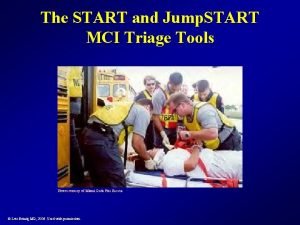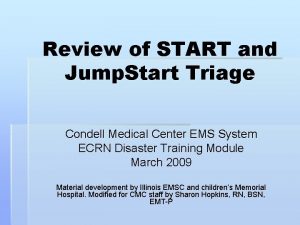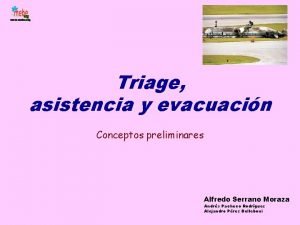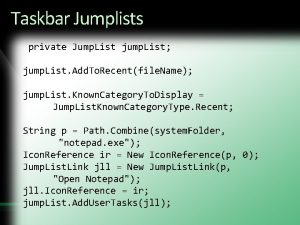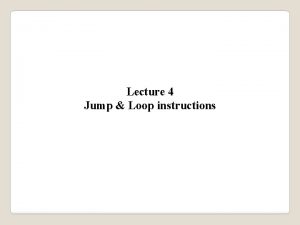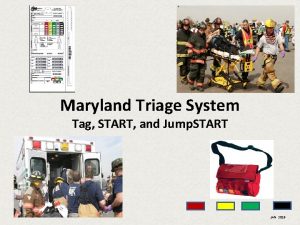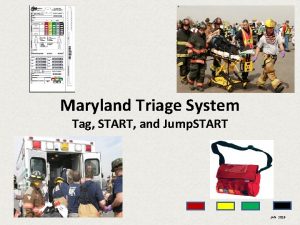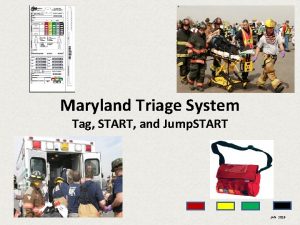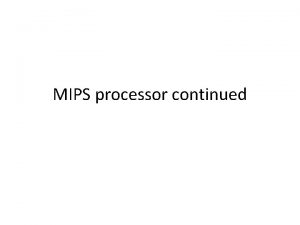Construction Management Jump Start Chapter 4 The Construction









































- Slides: 41

Construction Management Jump Start Chapter 4 The Construction Contract 1

Chapter 4 The Construction Contract • This chapter introduces you to the various documents included in the contract, how the contract impacts the construction, the standard protocols used when preparing the contract documents, and the various types of contracts used for construction. 2

What is a Construction Contract? • An agreement between the owner and contractor and is enforceable by law. • Contractor is to perform a service for some consideration or payment. • The contract is comprised of many documents. • The plans and specs are often referred to as the contract documents and the contractor must deliver the project in accordance with them. 3

Contract Documents • In a traditional project delivery method, the contractor is typically not involved in the design or production of the contract documents. • Contract documents consist of two major components: – Drawings (Plans) discuss the quantity of the work – Project Manual (Specs) discuss the quality of the work 4

The Drawings • The drawings are a graphical set of directives prepared by the expressing the wishes and desires of the owner. • The most important communication tool used to convey the work. • A shift in the design and construction process occurred during the Renaissance. – Prior to the Renaissance master builders communicated design with models – During the Renaissance, master builders began expressing their design through drawings and written instructions. • Today models have been reintroduced to supplement drawings using 3 D and 4 D (4 D includes time/schedule) computer modeling. 5

Drawing Production • Historically, drawings have been called blueprints. • Blueprints were created through a process which reproduced hand-drafted drawings by printing white lines on blue paper. • Todays hand-drafting process prints blue lines on white paper; these drawings are actually referred to as bluelines. • However, most drawing today are produced electronically on computer aided design (CAD). 6

Drawing Size • Sets of drawings vary in size from a 3 -4 sheets for a small house to well over 100 sheets for large, magnificent structures. • Note: A single drawing sheet is typically 24” x 36” to 36” x 48”, but can be even larger; handling large sets of drawings can be very difficult. • One major advantage of CAD is the capability to manage drawing electronically, morphing 40 pound sets of drawings into an electronic file that can fit onto a light-weight CD-ROM. • Organization of drawings helps the many drawing users quickly navigate the drawings allowing them to find whatever information they are looking for. • Therefore, standard protocol has been established for organizing drawing sets. 7

Organization of the Drawings • The architect is in charge of creating the drawings, but he does not work alone. • Sub-consultants are hired, such as civil, mechanical, electrical, and structural engineers, to produce civil, mechanical, electrical, and structural plans. • Drawing sets are therefore broken down into sections that contain each discipline's drawings. • Some projects may differ slightly, and even contain additional sections but, following a cover sheet, standard protocol call for these sections in this order: – – – Civil drawings Architectural drawings Structural drawings Mechanical drawings Electrical drawings 8

Cover Sheet • The cover sheet usually will provide general information about the project: – – Owner will be noted Geographical location Sheet index Etc. 9

Civil Drawings • • • These drawings are usually prepared by a civil engineer, and describes all worked associated with the site. Site work includes such things as grading, demolition, excavation, site utilities, streets, curbs, and gutters and their details. Civil drawings are typically numbered C 1, C 2, C 3, and so on. 10

Architectural Drawings • • • Prepared by the architect and constitute bulk of the set. Describe overall aesthetics of the facility, including project size, shape and appearance. Detailed information regarding dimensions, materials, and quality are graphically depicted in this section. Comprised of floor plans, exterior elevations, and sections; door, window and finish schedules and architectural details also included. Numbered A 1, A 2, A 3, etc. 11

Structural Drawings • Prepared by a structural engineer. • Identify major components making up the structural frame, such as columns, beams, and girders. • Numbered S 1, S 2, S 3, etc. 12

Mechanical drawings • Prepared by a mechanical engineer. • Two major components: plumbing and heating, ventilating, and air conditioning (HVAC). • Plumbing drawings describe the installation of water, sewer, and gas lines. • HVAC drawings describe the installation of ductwork, air handling units, compressors, and other climate control equipment. • Fire protection can also be included in the mechanical drawings. • Numbered M 1, M 2, M 3, etc. 13

Electrical Drawings • Prepared by and electrical engineer. • Includes all rough wiring, transformers, and panel boxes, as well as receptacles, switches and lighting fixtures. • Communications, fiber optics, and computer wiring are also included. • Numbered E 1, E 2, E 3, etc. 14

Types of Drawings • To help the reader better understand plans, different drawings are incorporated each describing more detail. • The four basic types of drawings are plans, elevations, sections, and details. 15

Plans • Horizontal “cut” through building or bird’s eye view. • Several different plan views are incorporated into the drawings, such as foundations plans, floor plans, framing plans, and reflected ceiling plans. • Most plans are drawings to 1/4” scale, but some large drawings are drawn to 1/8” scale 16

Elevations • Depict what the building would look like when standing from the outside and looking at the building. • A separate elevation will be included for all four sides of a building. • The elevation is typically named for the direction the exterior wall faces. 17

Sections • Provide a deeper understanding of the design at certain key spots of the building. • Represents a vertical “cut” through the building from top to bottom. • Often drawn in ½” scale, but sometimes might be drawn in ¼” scale. 18

Details • Depict portions of a building “blown up” in scale to help explain finer elements of design. • They are drawn very large. • Can explain such things as connections, intersections, special features, or tricky construction details. 19

Errors or Discrepancies in Drawings • Discrepancies are very common in construction drawings. • Often the drawings will give contradictory instructions. • Clauses are generally written into the general conditions addressing this problem. • Typically the more-detailed drawing take precedence over the more-general drawings. – The book discusses and example where the foundation plans indicate a 24” wide 10” deep footing, but a section indicates 24” wide 8” deep footing, the section would take precedence and the footing would need to be only 8” deep. • Note: Specifications take precedence over the drawings 20

The Project Manual • It is the second part of the contract documents: referred to as the specs. • Provides written instruction to the builder. • Typically contains four primary sections: – Bidding documents – General conditions – Supplemental conditions – Technical specifications 21

Bidding Documents • Advertisement or invitation to bid: bid appears at the beginning of the project manual and describes how the contractor can get the work. • Instruction to bidders: bidders provides specific instructions regarding the bidding process, and includes: – Procedures for submitting questions and obtaining clarification during the bidding process. – Information regarding addendum receipt and inclusion. – Rules concerning submissions such as bond requirements, bid opening, rejection of bids, and awarding the project. – Expectations for post-bid deliverables (schedule of values, construction schedule, etc. ) 22

Bidding Documents (cont. ) • Bid forms: forms these are actual forms that need to be filled out when submitting the bid, and are included in this section. – Sections to be filled out include bid price, completion date, subcontractors, alternate pricing, and receipt of addendum. – Some projects have special requirements such as Minority or Women’s Business Enterprise (MWBE) participation. • The agreement form: form the contract form that will be signed by both parties after the contract is awarded. 23

Bidding Documents (cont. ) 24

General Conditions • The general conditions are one of the most important documents associated with the construction contract. • Responsibilities of each of the parties are clearly delineated and specific terms of the contract are defined in this section. • On page 101 of the text book is a list of standard clauses often appear in the general conditions. 25

Supplemental Conditions • These generally deal with conditions that are project specific. • They are considerations beyond the scope of the standard general conditions and serve as augmentation to the terms laid out in the general conditions. • Examples of project specific conditions include: – Soils and soil testing information. – Survey information provided by the owner. – Materials or other services provided by the owner. – Job signage requirements. – Traffic control and pedestrian safety – Phasing requirements – Security requirements – Temporary structure requirements 26

Technical Specifications • Make up the bulk of the project manual. • Deal directly with construction, as opposed to administrative aspects of the other sections. • Used in conjunction with the plans and identify requirements related to labor, materials, equipment, and procedures needed to complete the project. • Discuss the following aspects of the job: – – Quality of materials. Standard of workmanship. Methods of installations and erection. Quality control and quality assurance procedures. 27

The Construction Specification Institute (CSI) • CSI was founded in 1948 and serves all major disciplines involved in the design and construction industry. • Developed CSI Master. Format which is the standard format for construction specifications. 28

Mater. Format 1995 • The 1995 edition of Master. Format has 16 divisions: 1. 2. 3. 4. 5. 6. 7. 8. General Requirements Site Construction Concrete Masonry Metals Wood and Plastics Thermal and Moisture Protection Doors and Windows 9. Finishes 10. Specialties 11. Equipment 12. Furnishings 13. Special Construction 14. Conveying Systems 15. Mechanical 16. Electric 29

Master. Format 2004 • In 2004 CSI produced a new Master. Format to provide more detailed divisions for complex tasks such as mechanical or electrical. • Master. Format now has 49 divisions which are grouped together into 5 groups: – – – General requirements Facility Construction Facility Services Site and Infrastructure Process Equipment • Some sections have been reserved for new construction technologies that may emerge in the future. 30

General Requirements Subgroup • This subgroup contains just Division 01 – General Requirements. • This divisions and subgroup pertain to administrative aspects of the project. 31

Facility Construction Subgroup • This is the standard architectural division. • It contains division 2 – 19. 2. 3. 4. 5. 6. 7. 8. Existing Conditions Concrete Masonry Metals Wood and Plastics Thermal and Moisture Protection Openings 9. 10. 11. 12. 13. 14. Finishes Specialties Equipment Furnishings Special Construction Conveying Systems • Divisions 15 – 19 are reserved 32

Facility Services Subgroup • This subgroup contains mechanical, electrical and plumbing (MEP) sections. • It contains divisions 20 – 29. 20. (Reserved) 21. Fire Suppression 22. Plumbing 23. HVAC 24. (Reserved) 25. Integrated Automation 26. Electrical 27. Communications 28. Electronic Safety and Security 29. (Reserved) 33

Site and Infrastructure Subgroup • This is typically the first work done on projects before vertical construction occurs. • It contains divisions 30 – 39. 30. (Reserved) 31. Earthwork 32. Exterior Improvements 33. Utilities 34. Transportation 35. Waterway and Marine Construction • Divisions 36 – 39 reserved. 34

Process Equipment Subgroup • Industrial projects that require unique process equipment have their own subgroup. • It contains divisions 40 – 49. – Division 40 – 43 include: Process Integration, Material Processing, and Handling Equipment; Process Heating, Cooling, ad Drying Equipment; ad Process Gas and Liquid Handling, Purification, and Storage Equipment – Division 44: Pollution Control – Division 45: Industry-Specific Manufacturing Equipment – Division 46 – 47: (Reserved) – Division 48: Electrical Power Generation – Division 49: (Reserved) 35

CSI Numbering System • With the 2004 Master. Format, CSI developed a sixdigit numbering system for its divisions. • These six numbers are broken down into three levels, each represented by a pair of digits. • Level one (digits 1 & 2) represent the division. • Successive levels represent items found within the divisions. For example: Division Numbers Division Names Numbering System Level 1 Unit Masonry 04 20 00 Level 2 Clay Unit Masonry 04 21 00 Level 3 Brick Masonry 04 21 13 Level 4 Brick Veneer Masonry 04 21 13. 13 36

Contract Types • The owner determines which type of contract the project will follow. • Four basic types of contracts: lump sum, costplus-fee, guaranteed maximum price, and unit -price contracts. • All contain the standard sections described earlier but differ in two fundamental ways: – How the contractor’s price is quoted to the owner – How risk is allocated to each of the parties 37

Lump-Sum Contract • Most common type of contract. • Contractor agrees to complete the work for a single, lump-sum fee. • Contract assumes the plans and specs are accurate. Errors or omissions in the contract documents result in change orders. • Change orders result in extra work and/or extra time, both of which result in extra cost to the owner. Change orders should be anticipated on any design-bid-build project. • If cost overruns occur but are not the result of errors or omission in the plans and specs, the contractor must absorb those costs. 38

Cost-Plus-Fee Contract • Also referred to as a time & materials contract, the owner reimburses the contractor for the labor and material costs of the project plus a fixed fee or percentage of the cost. • Often used when scope is hard to define. • Significant risks to the owner while it guarantees the contractor a profit. 39

Guaranteed Maximum Price Contract • The guaranteed maximum price (GMP) contract is a variation of the cost-plus-fee contract, and is popular in design-build delivery. • Owner pays cost-plus-fee, but only up to the GMP. • Allows construction to start earlier since a price can be guaranteed before the plans are 100 % complete. 40

Unit-Price Contract • Used when work to be performed cannot be accurately measured ahead of time. • Common for heavy civil and highway type jobs. • Contractors apply a unit price to each bid item (e. g. a dollar amount per cubic yard of dirt excavation) and these unit prices are multiplied by the engineers estimate of the quantities. • Engineers estimates are ballpark figures but can be very inaccurate. 41
 We're gonna jump jump jump in the river
We're gonna jump jump jump in the river Triage start
Triage start Jumpstart pediatric triage
Jumpstart pediatric triage Jae in 8086
Jae in 8086 30 2 can do triage
30 2 can do triage Triaj aşamaları
Triaj aşamaları Start vs jumpstart triage
Start vs jumpstart triage Jump start triage
Jump start triage Triage jump start
Triage jump start Jumpstart triage
Jumpstart triage But we gotta start somewhere
But we gotta start somewhere Great gatsby ch 8 summary
Great gatsby ch 8 summary Hình ảnh bộ gõ cơ thể búng tay
Hình ảnh bộ gõ cơ thể búng tay Lp html
Lp html Bổ thể
Bổ thể Tỉ lệ cơ thể trẻ em
Tỉ lệ cơ thể trẻ em Chó sói
Chó sói Tư thế worms-breton
Tư thế worms-breton Hát lên người ơi alleluia
Hát lên người ơi alleluia Môn thể thao bắt đầu bằng từ đua
Môn thể thao bắt đầu bằng từ đua Thế nào là hệ số cao nhất
Thế nào là hệ số cao nhất Các châu lục và đại dương trên thế giới
Các châu lục và đại dương trên thế giới Công thức tính thế năng
Công thức tính thế năng Trời xanh đây là của chúng ta thể thơ
Trời xanh đây là của chúng ta thể thơ Cách giải mật thư tọa độ
Cách giải mật thư tọa độ Phép trừ bù
Phép trừ bù độ dài liên kết
độ dài liên kết Các châu lục và đại dương trên thế giới
Các châu lục và đại dương trên thế giới Thể thơ truyền thống
Thể thơ truyền thống Quá trình desamine hóa có thể tạo ra
Quá trình desamine hóa có thể tạo ra Một số thể thơ truyền thống
Một số thể thơ truyền thống Cái miệng xinh xinh thế chỉ nói điều hay thôi
Cái miệng xinh xinh thế chỉ nói điều hay thôi Vẽ hình chiếu vuông góc của vật thể sau
Vẽ hình chiếu vuông góc của vật thể sau Thế nào là sự mỏi cơ
Thế nào là sự mỏi cơ đặc điểm cơ thể của người tối cổ
đặc điểm cơ thể của người tối cổ V. c c
V. c c Vẽ hình chiếu đứng bằng cạnh của vật thể
Vẽ hình chiếu đứng bằng cạnh của vật thể Tia chieu sa te
Tia chieu sa te Thẻ vin
Thẻ vin đại từ thay thế
đại từ thay thế điện thế nghỉ
điện thế nghỉ Tư thế ngồi viết
Tư thế ngồi viết




